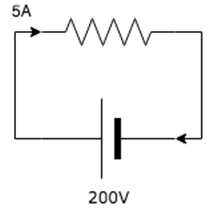This set of Basic Electrical Engineering Multiple Choice Questions & Answers (MCQs) focuses on “Resistivity”.
1. Materials which easily allow the passage of electric current are known as ______
a) Insulators
b) Conductors
c) Dielectrics
d) Semi-conductors
View Answer
Explanation: Conductors are materials(mostly metals), which freely allow the passage of electrons through it. If electrons can flow freely through a material, it implies that even current can flow freely through that material since current is the rate of flow of electrons.
2. A wire of length 2m and another wire of length 5m are made up of the same material and have the same area of cross section, which wire has higher resistance?
a) Both have equal resistance
b) The 2m wire has higher resistance
c) The 5m wire has higher resistance
d) The value of resistance cannot be determined from the given data
View Answer
Explanation: Resistance is directly proportional to the length of the wire, hence as the length of the wire increases, resistance increases.
3. A wire having an area of cross section = 10sqm and another wire having an area of cross section= 15sqm, have the same length and are made up of the same material. Which wire has more resistance?
a) Both have equal resistance
b) The 10sqm wire has higher resistance
c) The 15sqm wire has higher resistance
d) The value of resistance cannot be determined from the given data
View Answer
Explanation: Resistance is inversely proportional to the area of cross-section. As an area of cross-section increases, resistance decreases. Hence the 10sqm wire has a higher resistance than the 15sqm wire.
4. Which of the following statements are true with regard to resistance?
a) Resistance is directly proportional to a length of the wire
b) Resistance is directly proportional to an area of cross section of the wire
c) Resistance is inversely proportional to the length of the wire
d) Resistance is inversely proportional to the resistivity of the wire
View Answer
Explanation: The expression for resistance is: Resistance=Resistivity*length of wire/ area of cross section of the wire. Hence resistance is directly proportional to length.
5. A wire has the same resistance as the one given in the figure. Calculate its resistivity if the length of the wire is 10m and its area of cross section is 2m.

a) 16 ohm-metre
b) 8 ohm-metre
c) 16 kiloohm-metre
d) 8 kiloohm-metre
View Answer
Explanation: From the given circuit, R=V/I = 200/5 = 40ohm.
Resistivity= Resistance*Area of cross section/ Length of the wire.
Resistivity= 40*2/10= 8 ohm-metre.
6. Which, among the following is a unit for resistivity?
a) ohm/metre
b) ohm/metre2
c) ohm-metre
d) ohm-metre2
View Answer
Explanation: Resistivity = Resistance* Length/area of cross section.
Unit of resistivity = ohm*(m2)/m = ohm-m.
7. What is the resistivity of Copper?
a) 1.59*10-8ohm-m
b) 2.7*10-8ohm-m
c) 7.3*10-8ohm-m
d) 5.35*10-8ohm-m
View Answer
Explanation: Resistivity is a material property. Different materials have different resistivity. Resistivity of copper is 1.72*10-8 ohm-m.
8. Calculate the ratio of the resistivity of 2 wires having the same length and same resistance with area of cross section 2m2 and 5m2 respectively.
a) 5:7
b) 2:7
c) 2:5
d) 7:5
View Answer
Explanation: Resistivity = R*A/L
Since resistance and length of the two wires are same so resistivity is directly proportional to area of cross section. Ratio of area is 2:5 so the ratio of resistivity is also 2:5.
9. Which of the following statements are true with regard to resistivity?
a) Resistance depends on the temperature
b) Resistance does not depend on the temperature
c) Resistivity depend on the length
d) Resistivity depend on area of cross section
View Answer
Explanation: Resistivity is material property. It depends only on temperature.
For the same material with different length and area, resistivity remains the same until temperature remains constant.
10. The reciprocal of resistivity is________
a) Conductance
b) Resistance
c) Conductivity
d) Impedance
View Answer
Explanation: The expression for resistivity is = RA/l. The expression for conductivity = Cl/A; C=1/R => Conductivity = l/(AR) = 1/resistivity. Hence, conductivity is the reciprocal of resistivity.
Sanfoundry Global Education & Learning Series – Basic Electrical Engineering.
To practice all areas of Basic Electrical Engineering, here is complete set of 1000+ Multiple Choice Questions and Answers.
If you find a mistake in question / option / answer, kindly take a screenshot and email to [email protected]
